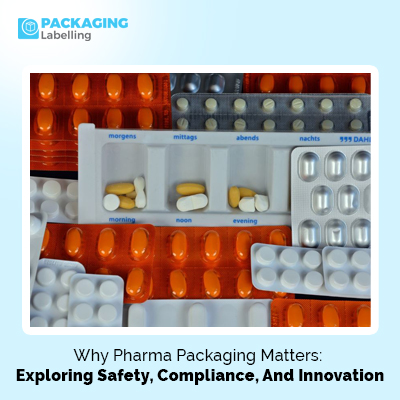Why Pharma Packaging Matters: Exploring Safety, Compliance, and Innovation

Introduction
In the rapidly evolving pharmaceutical industry, packaging plays a vital role in ensuring patient safety, compliance with regulatory standards, and fostering innovation. With strict regulations and dynamic market demands, pharma packaging has become more than just a container—it has become an indispensable tool for safeguarding medication efficacy and patient well-being.
Pharmaceutical packaging serves multiple functions, including protection from contamination, tampering, and environmental factors. It must also comply with stringent regulatory requirements, such as child-resistant closures and labeling standards. Meeting these criteria helps build trust between pharmaceutical companies and consumers, ensuring that medications reach patients in their intended form without compromising quality or safety. Moreover, pharma packaging is a catalyst for innovation. It offers opportunities to enhance medication administration, improve patient adherence, and facilitate dosing accuracy through smart packaging technologies. From blister packs designed for easy medication management to electronic monitoring devices embedded in packaging, advancements are transforming how medications are delivered and consumed.
In this article, we will delve deeper into why pharma packaging matters and explore the critical considerations of safety, compliance, and innovation. By understanding these factors, pharmaceutical manufacturers can strive to deliver the highest quality products while prioritizing patient welfare in an ever-changing industry landscape.
| Read More: Navigating Regulatory Challenges in Pharma: The Role of Innovative Packaging Solutions |
Importance of Pharma Packaging
Pharmaceutical packaging holds immense importance in the healthcare sector. It acts as the first line of defense against external contaminants and ensures the integrity of medications throughout their shelf life. A well-designed packaging system not only protects drugs from physical damage but also maintains their stability, potency, and purity, thereby ensuring optimal therapeutic outcomes for patients.
Additionally, pharma packaging plays a crucial role in preventing medication errors. Clear and concise labeling, coupled with user-friendly packaging designs, helps healthcare professionals and patients accurately identify medications, reducing the risk of administering the wrong drug or dosage. This aspect becomes particularly significant in high-stakes scenarios, such as emergencies or elderly care, where any error can have severe consequences. Furthermore, pharmaceutical packaging contributes to patient compliance and convenience. Packaging solutions that facilitate proper medication organization, such as unit-dose packaging or calendar packs, make it easier for patients to adhere to their prescribed regimens. This, in turn, improves treatment efficacy and reduces the likelihood of treatment failure or adverse events.
Safety in Pharma Packaging
Ensuring the safety of pharmaceutical products is a paramount concern for both manufacturers and regulatory bodies. Pharma packaging serves as a critical barrier against potential risks, such as contamination, counterfeiting, and tampering. By employing appropriate materials, technologies, and quality control measures, manufacturers can minimize the chances of these risks compromising the safety and efficacy of medications.
Contamination is a significant concern in the pharmaceutical industry, as it can render drugs ineffective or even harmful. Packaging materials with excellent barrier properties, such as aluminum foil or high-density polyethylene, create a protective shield against moisture, oxygen, and light, preserving the integrity of the enclosed medication. Additionally, sterile packaging techniques, like aseptic filling, ensure that injectable medications remain free from microbial contamination. Counterfeit drugs pose a significant threat to patient safety and public health. To combat this issue, pharmaceutical companies employ various anti-counterfeiting measures in their packaging, such as holographic labels, tamper-evident packaging seals, and unique identification codes. These measures help in distinguishing genuine products from counterfeit ones, empowering consumers to make informed choices and reducing the circulation of counterfeit medications.
Tamper-evident packaging is another crucial aspect of pharmaceutical safety. By incorporating features that indicate tampering, such as breakable seals or blister packs, manufacturers can assure consumers that the product has not been compromised during storage or transportation. These measures instill confidence in patients and healthcare providers, ensuring that medications are received in their intended state.
Compliance in Pharma Packaging
Pharmaceutical packaging must comply with a myriad of regulatory requirements to ensure patient safety and facilitate market access. Regulations and standards vary across different countries, regions, and product categories, making compliance a complex and challenging undertaking for pharmaceutical manufacturers.
Regulatory bodies, such as the U.S. Food and Drug Administration (FDA) and the European Medicines Agency (EMA), set guidelines that govern various aspects of pharma packaging, including labeling, child-resistant packaging, serialization, and product information. Compliance with these regulations is crucial to prevent legal repercussions, protect public health, and maintain the marketability of pharmaceutical products. Labeling standards play a vital role in pharmaceutical packaging compliance. Accurate and comprehensive labeling ensures that consumers have access to vital information, such as dosage instructions, side effects, and expiration dates. Additionally, labels must adhere to specific font sizes, colors, and placement guidelines to ensure legibility and clarity.
Child-resistant packaging is another critical aspect of compliance in pharmaceutical packaging. Medications that pose a risk to children, such as those containing opioids or other potent substances, must be packaged in child-resistant containers. These containers are designed to prevent young children from accessing the medication, reducing the chances of accidental ingestion and associated harm.
Serialization, or the unique identification of each package, has gained significant importance in recent years. This practice helps track and trace pharmaceutical products throughout the supply chain, ensuring transparency, and minimizing the risk of counterfeit medications entering the market. Serialization also aids in product recalls, as it enables efficient identification and removal of affected batches.
Regulations and Standards for Pharma Packaging
The pharmaceutical industry is subject to a comprehensive set of regulations and standards that govern all aspects of drug development, manufacturing, and distribution, including packaging. These regulations aim to ensure the safety, efficacy, and quality of pharmaceutical products and protect public health.
In the United States, the FDA plays a pivotal role in regulating pharmaceutical packaging. The FDA's Code of Federal Regulations (CFR) Title 21, specifically Part 211, sets forth the current good manufacturing practices (cGMPs) for pharmaceutical packaging. These regulations outline the requirements for packaging materials, labeling, quality control, and documentation, among other aspects. Similarly, the European Union (EU) has established regulations and directives that govern pharmaceutical packaging in its member states. The EU's Directive 2001/83/EC, as amended, outlines the requirements for packaging and labeling of medicinal products for human use. Additionally, the EU's Good Manufacturing Practice (GMP) guidelines provide detailed instructions on packaging operations and quality assurance.
Other countries and regions, such as Canada, Australia, and Japan, have their regulatory frameworks for pharmaceutical packaging. These regulations often align with international standards, such as those set by the International Organization for Standardization (ISO), ensuring a global harmonization of quality and safety standards.
Complying with these regulations is essential for pharmaceutical manufacturers to gain market approval and maintain product integrity. Failure to meet regulatory requirements can result in product recalls, fines, loss of reputation, and even legal consequences.
Innovations in Pharma Packaging
The pharmaceutical industry is witnessing an era of innovation in packaging, driven by advancements in materials, technologies, and consumer demands. These innovations aim to enhance medication safety, improve patient adherence, and provide healthcare professionals with valuable tools for effective treatment management.
One notable innovation in pharma packaging is the use of smart technologies. Smart packaging integrates electronic components, sensors, and connectivity features to offer enhanced functionality and real-time data monitoring. For example, packaging with embedded temperature sensors can monitor the temperature of sensitive medications during transportation, ensuring that they remain within the required storage conditions. Another area of innovation lies in the development of patient-friendly packaging solutions. Medication adherence is a significant challenge in healthcare, with studies showing that non-adherence leads to treatment failures, increased healthcare costs, and higher rates of hospitalization. To address this issue, packaging companies are designing user-centric solutions, such as easy-to-open blister packs, color-coded pouches, and audio-visual reminders, to help patients stay on track with their medication regimens.
Furthermore, the use of intelligent packaging technologies, such as near-field communication (NFC) or augmented reality (AR), is gaining traction in the pharmaceutical industry. These technologies enable consumers to access additional product information, instructional videos, or interactive features by simply scanning or interacting with the packaging. This not only enhances patient education but also empowers individuals to make informed decisions about their healthcare.
Sustainable Solutions in Pharma Packaging
As sustainability becomes a growing concern worldwide, the pharmaceutical industry is actively seeking eco-friendly packaging solutions. Traditional pharmaceutical packaging often involves excessive use of plastic, which contributes to environmental pollution and resource depletion. To address this issue, companies are exploring sustainable alternatives that minimize their ecological footprint.
One approach to sustainable pharma packaging is the use of biodegradable or compostable materials. These materials, such as bio-based plastics or paper-based packaging, offer similar protective properties while being more environmentally friendly. Additionally, recycling initiatives and the adoption of circular economy principles can help reduce waste and promote the reuse of packaging materials.
Moreover, pharmaceutical companies are focusing on optimizing packaging designs to minimize material usage. This includes lightweighting packaging components, redesigning bottle shapes to maximize space efficiency, and adopting minimalist packaging principles. By reducing the amount of packaging material used, manufacturers can cut down on waste generation and transportation costs, while also improving sustainability credentials.
Role of Technology in Pharma Packaging
Technology plays a pivotal role in shaping the future of pharmaceutical packaging. Advancements in materials science, automation, data analytics, and artificial intelligence are revolutionizing the way medications are packaged, distributed, and consumed.
One area where technology is making significant strides is in serialization and track-and-trace systems. These systems leverage unique identification codes, barcode scanning, and data management platforms to ensure supply chain visibility, reduce the risk of counterfeit drugs, and streamline inventory management. By enhancing traceability and transparency, technology-driven solutions help protect patient safety and maintain product integrity. Automation is another key aspect of technological advancements in pharma packaging. Automated packaging lines can handle high volumes of medications with precision and efficiency, reducing the risk of human error and enhancing productivity. Robotic systems, equipped with machine vision capabilities, can perform quality control inspections, ensuring that each package meets required standards before it reaches the market.
Data analytics and artificial intelligence (AI) are transforming packaging operations by providing valuable insights and predictive capabilities. By analyzing data from various sources, such as production lines, quality control checks, and consumer feedback, AI algorithms can identify patterns, detect anomalies, and optimize packaging processes. This enables manufacturers to make data-driven decisions, improve operational efficiency, and deliver high-quality products consistently.
Challenges in Pharma Packaging
While pharma packaging has made significant progress in ensuring patient safety and product integrity, it still faces several challenges that need to be addressed for continuous improvement.
One of the primary challenges is the need to strike a balance between safety and accessibility. While child-resistant packaging is essential for protecting children from accidental ingestion, it can pose difficulties for elderly or disabled patients who may struggle to open the packaging. Designing packaging solutions that offer both child resistance and ease of use is crucial to ensuring medication accessibility for all patient populations.
Another challenge is the complexity of global regulations and standards. Pharmaceutical companies operate in multiple markets, each with its own set of requirements, leading to variations in packaging designs and labeling. Harmonizing regulations and fostering international collaboration can simplify compliance efforts, reduce costs, and enhance patient safety through consistent packaging standards.
Sustainability poses another challenge for pharma packaging. While the industry is striving to adopt eco-friendly practices, implementing sustainable solutions can be cost-prohibitive and technically challenging. Balancing environmental considerations with cost-effectiveness and functional requirements remains a key challenge for packaging manufacturers.
Future Trends in Pharma Packaging
The future of pharma packaging holds immense potential for further advancements and innovations. Several trends are expected to shape the industry in the coming years, addressing current challenges and leveraging emerging technologies.
Personalized packaging is one such trend that is gaining traction. With the rise of personalized medicine and precision therapies, packaging can be customized to meet individual patient needs. This includes personalized dosing instructions, medication combinations, and packaging formats tailored to specific patient profiles. Personalized packaging not only enhances patient engagement but also improves treatment outcomes by aligning packaging with individualized therapy plans. Nanotechnology is another area of interest in pharma packaging.
Nanoscale materials and structures offer unique properties, such as enhanced barrier protection, controlled drug release, and improved stability. By incorporating nanotechnology into packaging designs, manufacturers can create more efficient and advanced packaging solutions that ensure medication safety and efficacy.
Additionally, the integration of blockchain technology holds promise for enhancing supply chain transparency and combating counterfeit drugs. Blockchain's decentralized and immutable nature provides a secure platform for tracking and tracing pharmaceutical products, reducing the risk of counterfeit medications entering the market. This technology also enables efficient recall management and facilitates seamless collaboration between different stakeholders in the supply chain.
Conclusion
Pharma packaging plays a critical role in ensuring patient safety, compliance with regulations, and fostering innovation in the pharmaceutical industry. By prioritizing safety, complying with regulatory requirements, and embracing technological advancements, pharmaceutical manufacturers can deliver high-quality products that meet the evolving needs of patients and healthcare providers.
As the industry continues to evolve, sustainability and patient-centric packaging solutions will become increasingly important. Striking a balance between safety, accessibility, and environmental considerations will be crucial for pharma packaging to thrive in the future. By staying abreast of emerging trends and regulatory changes, pharmaceutical companies can adapt their packaging strategies and contribute to a safer and more sustainable healthcare ecosystem.









